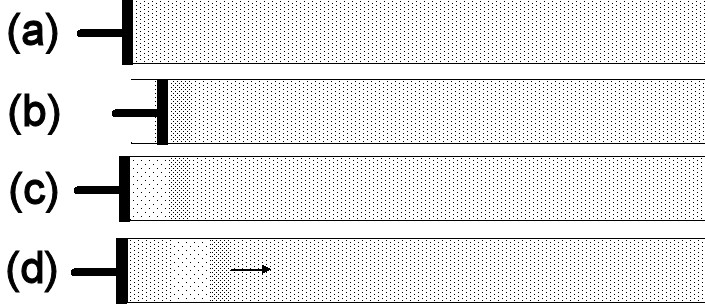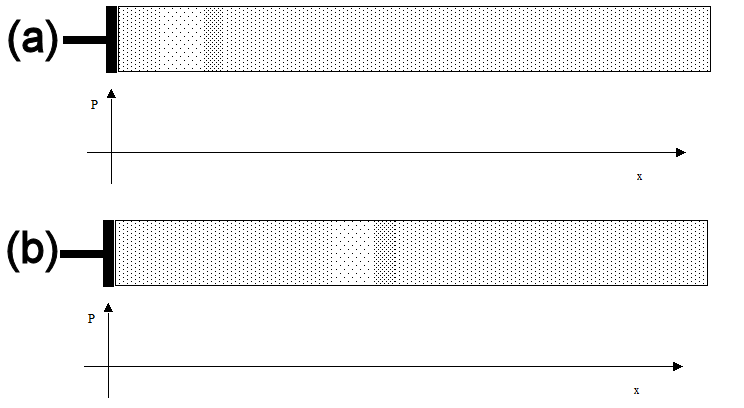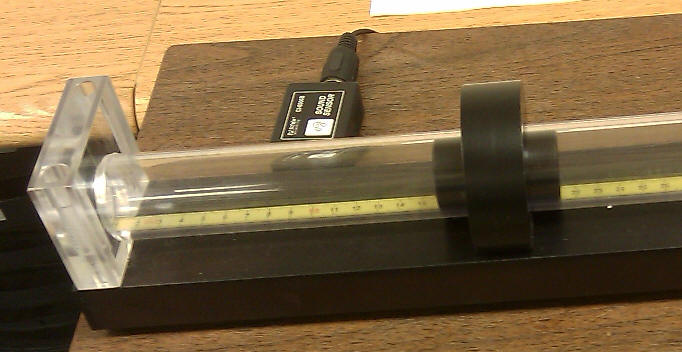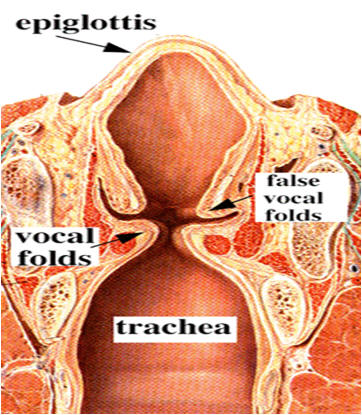

Vibrating objects can produce sound. Sound waves are longitudinal waves. They can travel through solids, liquids and gases. In this laboratory you will visualize the patterns of pressure variations associated with different sounds traveling through air and you will examine the frequency content of those patterns. You will also examine standing sound waves in a tube and measure the speed of sound waves in air.
Open a Microsoft Word document to keep a log of your experimental procedures, results and discussions. Address the points highlighted in blue. Answer all questions.
Exercise 1
Produce a sound pulse by clapping your hands once.
Sound is a pressure variation that propagates through a
gas or solid.
Consider a long, gas-filled cylinder with a piston on one end.

Note: While the pressure variation travels down the cylinder, the gas particles do not. They move back and forth over a relatively small distance.
Sketch pressure in the cylinder as a function of position along the cylinder axis for the figures (a) and (b) to the right.

This Word document contains the figures. Choose insert Shapes Lines, Scribble, and then sketch with the mouse.
Experiment 1
Most sounds we hear are not single sound pulses but more complex sound patterns. We will now explore some of those sound patterns.
(a) Compare the output of your computer's microphone for a clapping and a humming sound. The microphone converts pressure variations into voltage variations which can be recorded and displayed by the computer.
(b) Examine the output of your computer's microphone for the sound produced by a tuning fork.
(c) Any wave pattern can be produced by superimposing the appropriate sinusoidal waves. Breaking up the original sound wave into its sinusoidal components is called Fourier analysis. We can find the frequencies and amplitudes of the sine and cosine waves that must be added to produce our sound wave by letting the computer perform a Fourier analysis on the sound.
Screen capture and paste your graph into your log. What frequencies are strong in your "ahhh" sound? Without changing the pitch of your voice, change the sound from "ahhhh" to "eeee". What happens to the frequencies shown in the FFT display?
Experiment 2
Watch this Tube Resonance video.
Assume you had followed the procedure outline below to make measurements using a resonance tube and two tuning forks. With a magnet you can move a piston inside the resonance tube to adjust its length. The maximum length is 1 m. The tube has one open and one closed end. For a fixed frequency you can produce several resonances by varying the length of the tube. The closed end of a tube is a node in the longitudinal displacement. The open end of a tube is approximately an antinode in the longitudinal displacement.



Procedure:
This is the procedure that was followed to obtain the data in table 1.
Table 1
(tube length (m)))
| 1st harmonic L (m) |
3rd harmonic L (m) |
5th harmonic L (m) |
frequency f (Hz) |
temperature oC |
|
| fork 1 | 0.121 | 0.353 | 0.583 | 741 | 21 |
| fork 2 | 0.229 | 0.678 | not found | 384 | 21 |
Analyze the data and complete table 2.
The displacement nodes of standing waves in a tube are well defined, while the displacement antinodes at the ends can be displaced by a small distance from the actual ends of the tube. So it is best to use the distance between antinodes to to find the wavelength λ,
Table 2
| frequency f | wavelength λ | temperature TC | speed v = λf | |
| fork 1 | ||||
| fork 2 |
Compare your experimentally obtained value for the speed of sound with the
value obtained from the formula
v = (331.4 + (0.6/oC)TC) m/s.
Exercise 2 (optional)
 When you produce a sound, air from the lungs is pushed
through the vocal folds. This produces a train of air pulses.
As you speak, muscles in your larynx tighten the vocal folds. When
air from your lungs passes through the folds, they vibrate.
Vibrations at the resonance frequencies have the largest amplitudes. The
tighter the vocal cords, the higher are the resonance frequencies and
the higher is the pitch of your voice.
When you produce a sound, air from the lungs is pushed
through the vocal folds. This produces a train of air pulses.
As you speak, muscles in your larynx tighten the vocal folds. When
air from your lungs passes through the folds, they vibrate.
Vibrations at the resonance frequencies have the largest amplitudes. The
tighter the vocal cords, the higher are the resonance frequencies and
the higher is the pitch of your voice.
The pulse train produced by the vocal folds is shaped by the resonances of the vocal tract. The vocal tract acts like a variable filter. It is a filter because it amplifies certain frequencies and suppresses others. It is variable because by changing the position of your tongue, jaw, lips, etc. you can change the overall frequency response.
Link: The Human Voice
Develop a hypothesis to explain the frequency pattern observed when you make the "ahhh" sound.
Convert your log into a lab report.
Name:
E-mail address:
Laboratory 12 Report
Save your Word document (your name_lab12.docx), go to Canvas, Assignments, Lab 12, and submit your document.